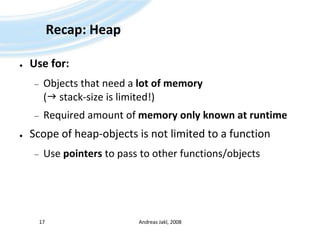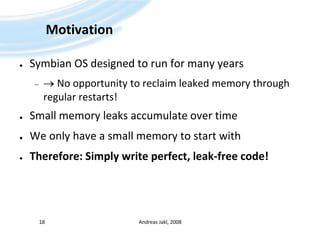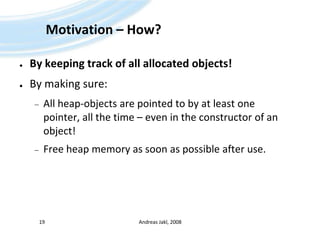Symbian OS - Memory Management
- 1. Symbian OSMemory Managementv2.0a – 21 May 20081Andreas Jakl, 2008
- 2. DisclaimerThese slides are provided free of charge at http://www.symbianresources.com and are used during Symbian OS courses at the University of Applied Sciences in Hagenberg, Austria ( http://www.fh-hagenberg.at/ )Respecting the copyright laws, you are allowed to use them:for your own, personal, non-commercial usein the academic environmentIn all other cases (e.g. for commercial training), please contact [email protected] correctness of the contents of these materials cannot be guaranteed. Andreas Jakl is not liable for incorrect information or damage that may arise from using the materials.Parts of these materials are based on information from Symbian Press-books published by John Wiley & Sons, Ltd. This document contains copyright materials which are proprietary to Symbian, UIQ, Nokia and SonyEricsson. “S60™” is a trademark of Nokia. “UIQ™” is a trademark of UIQ Technology. Pictures of mobile phones or applications are copyright their respective manufacturers / developers. “Symbian ™”, “Symbian OS ™” and all other Symbian-based marks and logos are trademarks of Symbian Software Limited and are used under license. © Symbian Software Limited 2006. Andreas Jakl, 20082
- 3. ScheduleLeaves, Panics and TRAP(D)CleanupstackObjectconstructionusingELeaveTwo-phaseconstructionDebugging toolsAndreas Jakl, 20083
- 4. Leaves & PanicsHandling problemsAndreas Jakl, 20084
- 5. Exceptions – JavaTry & Catch for handling exceptionsFunctions can throw “Exceptions”Andreas Jakl, 20085Integer Class…static intparseIntthrowsNumberFormatException {…}…Calling functionTry {int x = Integer.parseInt(“1234”);} catch (NumberFormatException e) {System.out.println(“Unable to convert this String to a number.”);}
- 6. Leave – SymbianTRAP(D) catches exceptions (“Leave”)Functions send out leaveFunction name marked by an L-suffixAndreas Jakl, 20086The TRAP(D) macros are defined in e32cmn.hMain-FunctionTRAPD(err, DoExampleL());if (err) { console->Printf(KTxtFailed, err); }DoExampleL()-FunctionvoidDoExampleL() {RFsfsSession; // Connect to the file serverUser::LeaveIfError(fsSession.Connect()); // …fsSession.Close(); }TRAPD-Makro declares err as TInt and = KErrNoneLeaves if the Connect() function does not return KErrNone
- 7. Central ExceptionHandlingAndreas Jakl, 20087New (ELeave) … … NewL() … … User::Leave() …… ConstructL() …F6L()F7L()F8L()F9L()F5L()F5L() … … F6L() ….… F8L() ….F3L()F4L()F0L()F2L()… F3L() …F4L() …F1L()TRAPD(err, F2L());if(err) …
- 8. Handling LeavesTry to implement central leave-handlingIf leave not handled by your code error-message shown by the UI-framework!Therefore: Only handle leaves yourself if they influence your applicationAndreas Jakl, 20088
- 9. When can a function leave?Caused by your own code:User::Leave(), User::LeaveIfError(), User::LeaveNoMemory() or User::LeaveIfNull()Failed object-constructionwhen using the “new (ELeave)”-operatorCalling a function that potentially causes a leavee.g. x->DoSomethingL()Andreas Jakl, 20089
- 10. Details: Causing a LeaveUser::Leave(TIntaReason)Error code (aReason) = value that will be received by TRAPCauses leave in any caseUser::LeaveIfError(TIntaReason)Causes leave if parameter is negative, e.g.:TIntfoundAt = iElementArray.Find(example, aRelation);User::LeaveIfError(foundAt); // Leaves if foundAt == KErrNotFound (-1)User::LeaveNoMemory()Is the same as: User:Leave(KErrNoMem);User::LeaveIfNull(TAny* aPtr)Andreas Jakl, 200810
- 11. TRAP / TRAPDTwo trap harness macros:TRAP: declares the variable in which the leave code is returnedTRAPD: declare a TIntvariable yourselfIf a leave occurs inside MayLeaveL(), which is executed inside the harness, the program code will return immediately to the TRAP harness macroThe variable result will contain the error code associated with the leave or will be KErrNoneif no leave occuredAndreas Jakl, 200811TRAPD(result, MayLeaveL());if (KErrNone!=result)...is equivalent to:TIntresult;TRAP(result, MayLeaveL());if (KErrNone!=result)...
- 12. TipsAndreas Jakl, 200812XvoidInsertData() {TInt err; TRAP(err, iData->InsertL(23));if (err) { ... } TRAP(err, iData->InsertL(24));if (err) { ... } }TRAPs are expensiveDon’t use several TRAPs right after each otherInstead:Make the function leave (append an L to the function name)Handle all errors in a single TRAP-call one level above!In UI apps, many leaves don’t have to be handled by you they can go up to the topmost level (= Active Scheduler)prefervoidHandleCommand() { TRAPD(err, InsertDataL());if (err) { ... } }voidInsertDataL() {iData->InsertL(23));iData->InsertL(24)); }
- 13. Panics... cannot be caught and handled!Terminates thread (= usually the whole application)Use them for checking code logic onlyCan also be sent out by the system for critical errorsIf a panic happens:Make sure you fix it, as you can’t handle it!Andreas Jakl, 200813// Stray signal detected!_LIT(KMsgStraySignal, "Stray signal\n");User::Panic(KMsgStraySignal, 1); // Panic with code 1
- 14. Resource HandlingStack, Heap and the Cleanup StackAndreas Jakl, 200814
- 15. Practice in a NutshellAll strategiesarepresent in thisfunction:Andreas Jakl, 200815CClass* CClass::NewL(TIntaInt, CBase& aObj){CClass* self = new (ELeave) CClass(aInt);CleanupStack::PushL(self);self->ConstructL(aObj);CleanupStack::Pop(self);returnself;}
- 16. Recap: StackAndreas Jakl, 200816// Stack (1)voidCTest::F1(){TInt x = 0;TInt y = 1;for(x = 0; x < 10; x++) y++ y = y + F2(); // Stack (4)}// Stack (5)TIntCTest::F2(){TInt a = 2;TInt b = 1;return a + b; // Stack (3)}Stack (2)Stack(5)Stack(1)TInt yTInt xF1Stack(2)TInt yTInt xF1Stack(4)TInt bTInt aF2TInt yTInt xF1Stack(3)
- 17. Recap: HeapUse for:Objects that need a lot of memory ( stack-size is limited!)Required amount of memoryonlyknown at runtimeScope of heap-objects is not limited to a functionUse pointers to pass to other functions/objectsAndreas Jakl, 200817
- 18. MotivationSymbian OS designed to run for many years No opportunity to reclaim leaked memory through regular restarts!Small memory leaks accumulate over timeWe only have a small memory to start withTherefore: Simply write perfect, leak-free code!Andreas Jakl, 200818
- 19. Motivation – How?By keeping track of all allocated objects!By making sure:All heap-objects are pointed to by at least one pointer, all the time – even in the constructor of an object!Free heap memory as soon as possible after use.Andreas Jakl, 200819
- 20. The Cleanup StackSafeguardAndreas Jakl, 200820
- 21. Resource Handling – Rule 1Andreas Jakl, 200821Every local pointer to an instance of a heap-based object also has to be pushed on the cleanup stack, if there‘s the risk that the pointer gets lost because of a leave.
- 22. Cleanup StackSituation: function creates local heap-objectBefore code gets to the delete-statement: errorFunction is left (Leave)Pointer-address on the stack is freedObject itself is orphaned memory leak!Andreas Jakl, 200822voidCImage::DoSomethingDangerousL() { User::Leave(KErrNotFound); }CImagevoidCMyObj::DoSomethingL(){}CImage* img = new (ELeave) CImage();img->DoSomethingDangerousL();deleteimg;img = pointer on the stack to an instance on the heap
- 23. Cleanup StackMemory situation if a leave occurs:Andreas Jakl, 200823!XXimgHeapStackObject stays on the heap;Pointer to delete the instance is lostmemory leak
- 24. Cleanup StackSolution: Cleanup StackAndreas Jakl, 200824void CMyObj::DoSomethingL(){CImage* img = new (ELeave) CImage();CleanupStack::PushL(img);img->DoSomethingDangerousL();CleanupStack::PopAndDestroy();}imgCleanupStackXXimgHeapStackWhen no leave occurs: object still has to be deleted by you + removed from the cleanup stack!Cleanup stack saves a second pointerto the object on the heap.
- 25. AdvancedCleanupAndreas Jakl, 200825RFileForresourcesthathavetobeclosed / freed(e.g.: files, sockets, …)Close(): CleanupClosePushL(T&)Release(): CleanupReleasePushL(T&)Destructor: CleanupDeletePushL(T*)Close()TCleanupOperationTAny* aPtr…TCleanupItemCleanupStack
- 26. AdvancedCleanup – ExampleAndreas Jakl, 200826voidCMyClass::TransferDataL() {RSocketServsocketServer; // Connect to SocketServer User::LeaveIfError( socketServer.Connect() ); // Make sure Close() is called at the endCleanupClosePushL( socketServer );// …CleanupStack::PopAndDestroy(); // socketServer }
- 27. Cleanup Stack and Ownership TransferIt should never be possible for an object to be deleted more than once!Andreas Jakl, 200827voidTransferOwnershipExampleL() { // The stack variable ptr points to memory allocated on the heapCItem* ptr = new (ELeave) CItem(); // The following function may leave -> place the pointer on the // cleanup stack, so that the heap memory is freed in case // AppendL() leaves.CleanupStack::PushL(ptr); // iItemPtrArray takes ownership of the CItem object. // This could fail, as it needs to allocate a new slot to store the pointer, // therefore the object was placed on the cleanup stack in advanceiItemPtrArray->AppendL(ptr); // iItemArray now owns the heap object, so ptr may be safely popped off the stack. // It shouldn’t be destroyed, as this would make the item in iItemPtrArray invalid!CleanupStack::Pop(ptr); }
- 28. Practice in a NutshellStrategiesexplaineduptonow:Andreas Jakl, 200828CClass* CClass::NewL(TIntaInt, CBase& aObj){CClass* self = new (ELeave) CClass(aInt);CleanupStack::PushL(self);self->ConstructL(aObj);CleanupStack::Pop(self);returnself;}
- 29. Resource Handling – Rule 2Andreas Jakl, 200829Never push instance variables on the cleanup stack!The owning class is also on the cleanup stack somewhere (at least indirectly). This would lead to a double deletion of the object pointed to by the instance variable Panic!
- 30. Coding Error ExampleAndreas Jakl, 200830class CSimple : CBase { public: ~CSimple(); void MayLeaveFuncL();private: void PrivateMayLeaveL();CItem* iItem; };CSimple* simple = new (ELeave) CSimple();CleanupStack::PushL(simple);1. CSimple is created and pushed onto the cleanup stack as the next function may leaveTRAPD(res,simple->MayLeaveFuncL());...2. A leaving method is called on simplevoid CSimple::MayLeaveFuncL() {iItem= new (ELeave) CItem();CleanupStack::PushL(iItem);PrivateMayLeaveL();CleanupStack::Pop(iItem); }3. The member variable is pushed onto the clean up stack (oops!)5. The TRAP does the right thing and clears the cleanup stack; i.e. CSimple::iItem is deleted 4. What happens if a leaves occurs? ...6. The code logic completes with the popping and deleting of the simple object.CleanupStack::PopAndDestroy(simple);CSimple::~CSimple { delete iItem; }BUT this calls the CSimple destructor, which deletes the iItem which has already been deleted by the TRAP 7. PANIC!Example taken from theSymbian Academy slides
- 31. Object ConstructionLeave-handling duringAndreas Jakl, 200831
- 32. New Objectsnew-operator allocates memory and runs constructorReturns null-pointer if object creation fails(e.g. not enough memory) manual test required to see if it was successful – no automated leave!Andreas Jakl, 200832void CMyObj::DoSomethingL() {CImage* img = newCImage(); if (img) {CleanupStack::PushL(img);img->DoSomethingDangerousL();CleanupStack::PopAndDestroy();} else { User::LeaveNoMemory(); } }
- 33. New Objects – ELeaveAndreas Jakl, 200833void CMyObj::DoSomethingL() {CImage* img = newCImage(); if (img) {CleanupStack::PushL(img);img->DoSomethingDangerousL();CleanupStack::PopAndDestroy();} else { User::LeaveNoMemory(); } }void CMyObj::DoSomethingL() {CImage* img = new (ELeave)CImage();CleanupStack::PushL(img);img->DoSomethingDangerousL();CleanupStack::PopAndDestroy(); }identicalnew-Operator overloaded with ELeave:automated leave if there’s not enough memory!
- 34. Practice in a NutshellStrategiesexplained so far:Andreas Jakl, 200834CClass* CClass::NewL(TIntaInt, CBase& aObj){CClass* self = new (ELeave) CClass(aInt);CleanupStack::PushL(self);self->ConstructL(aObj);CleanupStack::Pop(self);returnself;}
- 35. Two-Phase ConstructionThe ultimate combination …Andreas Jakl, 200835
- 36. Resource Handling – Rule 3Andreas Jakl, 200836Neither a constructor nor a destructor may cause a leave!The destructor must not assume that the object was fully initialized.
- 37. Leaves in the ConstructorAndreas Jakl, 2008371. Call to constructorof CEngineApplicationCEngine* myEngine = new (ELeave) CEngine();……CEngineCEngine::CEngine() {iList = new (ELeave) CList();}CEngine::~CEngine() {deleteiList;}iListCEngine2. Leave – nomemory left for allocating iListHeap3. Because of the leavethere is no valid pointerto the partially constructedCEngine-object.4. Without a validpointer, the memoryalready allocatedfor CEngine is lost.?
- 38. Solution: Two-phase ConstructionAndreas Jakl, 200838ApplicationCEngine* myEngine = new (ELeave) CEngine();CleanupStack::Push(myEngine);myEngine->ConstructL();…// Note that the following line won’t be // reached in case of a leave!CleanupStack::PopAndDestroy(myEngine);CEngineCEngine::CEngine() {// 1. Phase}CEngine::ConstructL() {// 2. PhaseiList = new (ELeave) CList();}CEngine::~CEngine() {deleteiList;}iListCEngineHeapObject is fully allocated and on the cleanup stack the destructor can be executed, the class is deleted by the cleanup stack all memory is properly cleaned up in case of a leave!
- 39. Simplification: Two-phase ConstructionLess complicated creation of objects:Trailing C at the end of the function name: an object is left on the cleanup stack (as in NewLC())Andreas Jakl, 200839CEngineCEngine* CEngine::NewLC() {CEngine* self = new (ELeave) CEngine(); // 1. PhaseCleanupStack::PushL(self); self->ConstructL(); // 2. Phasereturn self;}CEngine* CEngine::NewL() {CEngine* self = CEngine::NewLC();CleanupStack::Pop(self);return self;}Application – Local VariableCEngine* myEngine = CEngine::NewLC();…CleanupStack::PopAndDestroy(myEngine);orApplication– Instance VariableiMyEngine = CEngine::NewL();Destructor:delete iMyEngine;Application – Instance variableiMyEngine = CEngine::NewL();// Destructor:deleteiMyEngine;
- 40. Practice in a NutshellStrategiesexplained so far:Andreas Jakl, 200840CClass* CClass::NewL(TIntaInt, CBase& aObj){CClass* self = new (ELeave) CClass(aInt);CleanupStack::PushL(self);self->ConstructL(aObj);CleanupStack::Pop(self);returnself;}
- 41. DerivationNote:Some thoughts are necessary when deriving from a class that uses two-phase constructionSee the literature or Symbian Academy-slides for details!Andreas Jakl, 200841
- 42. Resource Handling – Rule 4Andreas Jakl, 200842If memory for a pointer (instance variable) is reallocated, set the old pointer to NULL beforehand.
- 43. NULLSituation (without NULL):AllocL() causes a leave, which propagates up …Instance of CElement is deletedDestructor of CElement is callediName still points to already deleted memoryDeleted 2x PanicAndreas Jakl, 200843voidCEngine::DoStuffL(constTDesC& aName) {CElement* element = CElement::NewLC(); TRAPD(err, element->SetNameL(aName));CleanupStack::PopAndDestroy(element); }21voidCElement::SetNameL(constTDesC& aName) {deleteiName; // Deletes object, does not change pointeriName = aName.AllocL(); // Re-Allocation }voidCElement::~CElement() {deleteiName; }12iName = NULL; // Deletes pointer on stackNote: delete does not delete a NULL pointer.
- 45. SummaryCatch leaves (= exceptions) with TRAP(D)Use cleanup stack for local heap-based variablesDo not use the cleanup stack for instance variablesNo leaves in constructors or destructorsUse two-phase construction for objects with data on the heapSet a pointer to NULL before re-allocating memoryAndreas Jakl, 200845!
- 46. What’s wrong?Andreas Jakl, 200846CleanupStack::PushL(iList);
- 47. What’s wrong?Andreas Jakl, 200847CleanupStack::PushL(iList);Never push instance variables on the cleanup stack!Twice as safe isn’t safe at all…
- 48. What’s wrong?Andreas Jakl, 200848CEngine* engine = new (ELeave) CEngine();…CleanupStack::PopAndDestroy(engine)
- 49. What’s wrong?Andreas Jakl, 200849CEngine* engine = new (ELeave) CEngine();…CleanupStack::PopAndDestroy(engine)enginewasn‘t pushed on the cleanup stack!new (ELeave) is only responsible for leaving if memory allocation for the object fails. new (ELeave) has nothing to do with the cleanup stack.Solution: Either: add the object to the cleanup stack:CleanupStack::PushL(engine);Or: don’t use the cleanup stack for deleting – in case no leaving operation is called between creation and deletion of the engine object:delete engine;
- 50. What’s wrong?Andreas Jakl, 200850voidCGomokuViewGame::ChangeViewContextText(TIntaResourceId) {RBufnewText(iEikonEnv->AllocReadResourceL(resourceId));newText.CleanupClosePushL ();MQikViewContext* viewContext = ViewContext (); // Changing an alreadyexistingviewcontexttextviewContext->ChangeTextL (EGomokuViewContext, newText);CleanupStack::PopAndDestroy (1); // newText }
- 51. What’s wrong?Andreas Jakl, 200851void CGomokuViewGame::ChangeViewContextText(TInt aResourceId) { RBuf newText(iEikonEnv->AllocReadResourceL(resourceId)); newText.CleanupClosePushL (); MQikViewContext* viewContext = ViewContext (); // Changing an already existing view context text viewContext->ChangeTextL (EGomokuViewContext, newText); CleanupStack::PopAndDestroy (1); // newText }The trailing L of the function name is missing, as calls withinthe function can leave.Solution:void CGomokuViewGame::ChangeViewContextTextL(…)
- 52. Testing your CodeOn your way to perfectionAndreas Jakl, 200852
- 53. Macros for TestingWrap code you want to test within __UHEAP_MARK and __UHEAP_MARKEND:Andreas Jakl, 200853CClass* p1 = new (ELeave) CClass;__UHEAP_MARK;// Mark start of test-areaCClass* p2 = new (ELeave) CClass;CClass* p3 = new (ELeave) CClass;__UHEAP_CHECK(2);// 2 Objects (p2, p3) on the heap since the start-mark__UHEAP_CHECKALL(3);// In total 3 objects on the heapdelete p3;_UHEAP_MARKEND;// Result: p2 is still here – Memory Leak!// or: __UHEAP_MARKENDC(1);// Expects one cell on the heap
- 54. Finding Memory LeaksEmulator checksheapautomaticallyifyouexittheprogram BEFORE closingtheemulatorwindow!Andreas Jakl, 200854Find it in theSymbian OS SDK doc:Symbian OS SDK v… Symbian OS guide Symbian OS reference System panicreference
- 56. Allocation FailureIntentional failing of memory allocation:__UHEAP_SETFAIL(aType, aValue);EDeterministic: fail every nth requestERandom: fail randomly once within a specified range – always using the same seedETrueRandom: random seed taken from system timeAndreas Jakl, 200856__UHEAP_SETFAIL(RHeap::EDeterministic, 2);CObj* c1 = new (ELeave) CObj; // will allocateCObj* c2 = new (ELeave) CObj; // will failCObj* c3 = new (ELeave) CObj; // will allocateCObj* c4 = new (ELeave) CObj; // will fail__UHEAP_RESET; // Deactivate
- 57. FAILNEXTFails thenextallocationrequestAndreas Jakl, 200857CObj* c1 = new (ELeave) CObj; // will allocate__UHEAP_FAILNEXT(1);// failnextallocationCObj* c2 = new (ELeave) CObj; // will fail
- 58. AllocationFailureIn theemulator, withoutwritingcode:Heap Failure ToolActivate:Ctrl+Alt+Shift+PDeactivate:Ctrl+Alt+Shift+QCan failheap, WindowServer-allocationsorfile-accessAndreas Jakl, 200858
- 59. … let’s move to the Challenges!Try it for your ownAndreas Jakl, 200859



























































